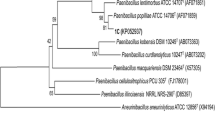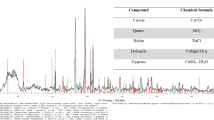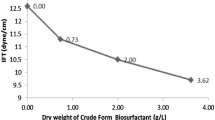Abstract
The facultative anaerobe Pantoea sp. strain A-13, isolated from ornithogenic soil of Dewart Island (Frazier Islands), Antarctica, produced glycolipid biosurfactants when grown on n-paraffins or kerosene as the sole source of carbon and energy. Hemolysis of erythrocytes, growth inhibition of Bacillus subtilis, and thin-layer chromatography studies have suggested that the secreted glycolipids are rhamnolipids. Glycolipids produced by kerosene-grown cells decreased the surface tension at the air–water interface to 30 mN/m and possessed a low critical micelle concentration value of 40 mg/l, which indicated high surface activity. They efficiently emulsified aromatic hydrocarbons, kerosene, and n-paraffins. Biosurfactant production contributed to an increase in cell hydrophobicity, which correlated with increased growth of the strain on tested hydrocarbons. According to the results, the Antarctic biosurfactant-producing strain Pantoea sp. A-13 appears to be valuable source for application in accelerated environmental bioremediation.



Similar content being viewed by others
Literature Cited
Aislabie J, Balks M, Astori N, Stevenson G, Symons R (1999) Polycyclic aromatic hydrocarbons in fuel oil–contaminated soils, Antarctica. Chemosphere 39:2201–2207
Aislabie J, McLeod M, Fraser R (1998) Potential of biodegradation of hydrocarbons in soil from the Ross Dependency, Antarctica. Appl Microbiol Biotechnol 49:210–214
Asis CA, Adashi K (2004) Isolation of endophytic diazotroph Pantoea agglomerans and nondiazotroph Enterobacter asburiae from sweet potato stem in Japan. Lett Appl Microbiol 38:19–23
Baraniecki CA, Aislabie J, Foght JM (2002) Characterization of Sphingomonas sp. Ant 17, an aromatic hydrocarbon-degrading bacterium isolated from Antarctic soil. Microbial Ecol 43:44–54
Batista SB, Mounteer AH, Amorim FR, Totola MR (2006) Isolation and characterization of biosurfactant/bioemulsifier from petroleum-contaminated sites. Bioresour Technol 97:868–875
Beal R, Betts WB (2000) Role of rhamnolipid biosurfactants in the uptake and mineralization of hexadecane in Pseudomonas aeruginosa. J Appl Microbiol 89:158–168
Berg G, Seech AG, Lee H, Trevors JT (1990) Identification and characterization of a soil bacterium with extracellular emulsifying activity. J Environ Sci Health 25:753–764
Bergey’s manual of systematic bacteriology. Baltimore: Williams and Wilkins
Bodour AA, Maier RM (2002) Biosurfactants: types, screening methods, and applications. In: Bitton G (ed) Encyclopedia of environmental microbiology. Hoboken, New Jersey: John Wiley and Sons Inc, pp 750–770
Boulton CA, Ratledge C (1987) Biosynthesis of lipid precursors to surfactant production. In: Kosaric N (ed) Biosurfactants. Surfactant Science Series. New York: Marcel Dekker 25:48–83
Bradford MM (1976) A rapid and sensitive method for the quantitation of microgram quantities of protein utilizing the principle of protein-dye binding. Analyt Biochem 72:248–254
Desai JD, Banat IM (1997) Microbial production of surfactants and their commercial potential. Microbiol Mol Biol Rev 61:47–64
Diaz E, Fernandez A, Prieto MA, Garcia JL (2001) Bioremediation of aromatic compounds by Escherichia coli. Microbiol Mol Biol Rev 65:523–569
Gavini F, Mergaert J, Beji A, Mielcarek C, Izard D, Kersters K, De Ley J (1989) Transfer of Enterobacter agglomerans (Beijerinck 1888) Ewing and Fife 1972 to Pantoea gen. nov. as Pantoea agglomerans comb. nov. and description of Pantoea dispersa sp. nov. Int J Syst Bacteriol 39:3337–3345
Haba E, Espuny MJ, Busquets M, Manresa A (2000) Screening and production of rhamnolipids by Pseudomonas aeruginosa 47T2 NCIB 40044 from waste frying oils. J Appl Microbiol 88:379–387
Harada H, Ishikawa H (1997) Phylogenetical relationship based on groE genes among phenotypically related Enterobacter, Pantoea, Klebsiella, Serratia, and Erwinia species. J Gen Appl Microbiol 43:355–360
Hommel RK (1994) Formation and function of biosurfactants for degradation of water-insoluble substrates. In: Ratledge C (ed) Biochemistry of microbial biodegradation. Dordrecht: Kluwer Academic Publishers, pp 63–87
Itoch S, Honda H, Tomita F, Suzuki T (1971) Rhamnolipid produced by Pseudomonas aeruginosa grown on n-paraffin. J Antibiot 24:855–859
Johnson MK, Boese-Marrazzo D (1980) Production and properties of heat-stable extracellular hemolysin from Pseudomonas aeruginosa. Inf Immun 29:1028–1033
Kates M (1972) Techniques of lipidology. In: Work TSWE (ed) Biochemistry and biochemical biology. Amsterdam: North-Holland Publishing Co, pp 393–444
Kennicutt II, MC McDonald TJ, Denoux GJ, McDonald SJ (1992) Hydrocarbon contamination on the Antarctic Peninsula: I. Arthur Harbor—subtidal sediments. Mar Pollut Bull 24:499–506
Kitamoto D, Isoda H, Nakahara T (2002) Functions and potential applications of glycolipid biosurfactants: From energy-saving materials to gene delivery carriers. J Biosci Bioeng 94:187–201
Koch AK, Kappeli O, Fiechter A, Reiser (1991) Hydrocarbon assimilation and biosurfactant production in Pseudomonas aeruginosa mutants. J Bacteriol 173:4212–4219
Lang S, Wullbtandt D (1999) Rhamnose lipids: Biosynthesis, microbial production and application potential. Appl Microbiol Biotechnol 51:22–32
Leahy JG, Colwell RR (1990) Microbial degradation of hydrocarbons in the environment. Microbiol Rev 54:305–315
Makkar RS, Cameotra SS (2002) An update on the use of unconventional substrates for biosurfactant production and their new applications. Appl Microbiol Biotechnol 58:428–434
Mulligan CN (2005) Environmental applications for biosurfactants. Environ Pollution 133:183–198
Pepi M, Cesaro A, Liut G, Baldi F (2005) An Antarctic psychrotrophic bacterium Halomonas sp. ANT-3b, growing on n-hexadecane, produces a new emulsifying glycolipid. FEMS Microb Ecol 53:157–166
Pruthi V, Cameotra SS (1997) Production and properties of a biosurfactant synthesized by Arthrobacter protophormiae—an Antarctic strain. World J Microbiol Biotechnol 13:137–139
Ron EZ, Rosenberg E (2002) Biosurfactants and oil bioremediation. Current Opin Biotechnol 13:249–252
Rosenberg E (1993) Exploiting microbial growth on hydrocarbon: New markets. Trends Biotechnol 11:419–424
Rosenberg M, Gutnick D, Rosenberg E (1980) Adherence of bacteria to hydrocarbons: A simple method for measuring cell surface hydrophobicity. FEMS Microbiol Lett 9:29–33
Sarma PM, Bhattacharya D, Krishnan S, Lal B (2004) Degradation of polycyclic aromatic hydrocarbons by a newly discovered enteric bacterium, Leclercia adecarboxylata. Appl Environ Microbiol 70:3163–3166
Scholz-Seidel C, Ruppel S (1992) Nitrogenase and phytohormone activities of Pantoea agglomerans in culture and their reflection in combination with wheat plants. Zentralbl Microbiol 147:319–328
Shulga A, Karpenko Е, Vildanova-Martsishin R, Turovsky A, Soltys M (2000) Biosurfactant-enhanced remediation of oil-contaminated environments. Adsorpt Sci Technol 18:171–176
Van Loosdrecht MC, Lyklema J, Norde W, Schraa G, Zehnder AJB (1987) The role of bacterial cell wall hydrophobicity in adhesion. Appl Environ Microbiol 53:1893–1897
Vasileva-Tonkova E, Gesheva V (2004) Potential for biodegradation of hydrocarbons by microorganisms isolated from Antarctic soils. Z Naturforsch 59c:140–145
Vasileva-Tonkova E, Gesheva V (2005) Glycolipids produced by Аntarctic Nocardioides sp. during growth on n-paraffin. Process Biochem 40:2387–2391
Wei YH, Chou CL, Chang JS (2005) Rhamnolipid production by indigenous Pseudomonas aeruginosa J4 originating from petrochemical wastewater. Biochem Eng J 27:146–154
Wright SAI, Zumoff CH, Schneider L, Beer SV (2001) Pantoea agglomerans strain EH318 produces two antibiotics that inhibit Erwinia amylovora in vitro. Appl Environ Microbiol 67:284–292
Wu L, Birch RG (2004) Characterization of Pantoea dispersa UQ68J: Producer of a highly efficient sucrose isomerase for isomaltose biosynthesis. J Appl Microbiol 97:93–103
Zhang Y, Miller RM (1994) Effect of a Pseudomonas rhamnolipid biosurfactant on cell hydrophobicity and biodegradation of octadecane. Appl Environ Microbiol 60:2101–2106
Author information
Authors and Affiliations
Corresponding author
Rights and permissions
About this article
Cite this article
Vasileva-Tonkova, E., Gesheva, V. Biosurfactant Production by Antarctic Facultative Anaerobe Pantoea sp. During Growth on Hydrocarbons. Curr Microbiol 54, 136–141 (2007). https://doi.org/10.1007/s00284-006-0345-6
Received:
Accepted:
Published:
Issue Date:
DOI: https://doi.org/10.1007/s00284-006-0345-6




